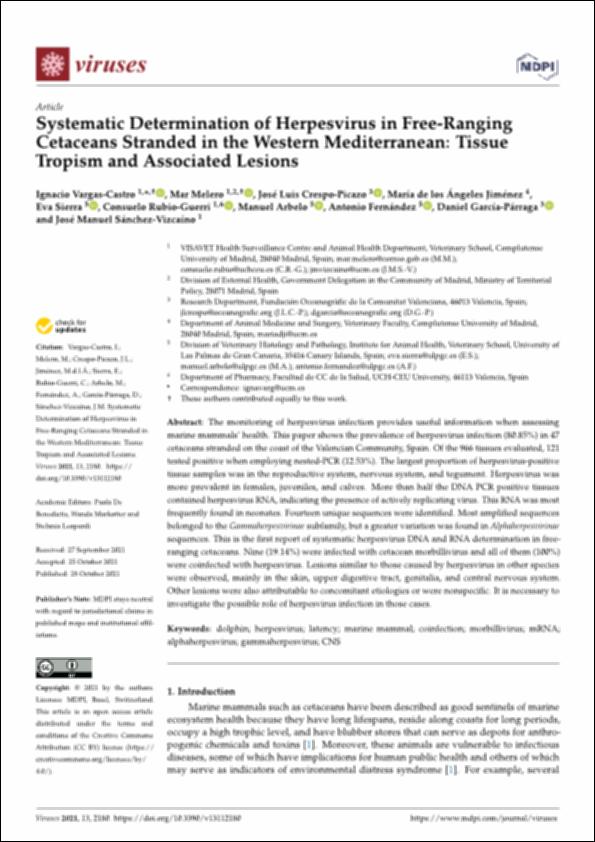Por favor, use este identificador para citar o enlazar este ítem:
http://hdl.handle.net/10637/13993Systematic determination of herpesvirus in free-ranging cetaceans stranded in the Western Mediterranean : tissue tropism and associated lesions
| Título : | Systematic determination of herpesvirus in free-ranging cetaceans stranded in the Western Mediterranean : tissue tropism and associated lesions |
| Autor : | Vargas Castro, Ignacio Melero Asensio, Mar Crespo Picazo, José Luis Jiménez Martínez, María de los Ángeles Sierra Pulpillo, Eva María Rubio Guerri, Consuelo |
| Materias: | Enfermedades por herpesvirus.; Herpesvirus diseases.; Marine mammals - Diseases.; Dolphins - Diseases.; Mamíferos marinos - Enfermedades.; Delfines - Enfermedades. |
| Editorial : | MDPI |
| Citación : | Vargas-Castro, I., Melero, M., Crespo-Picazo, J. L., Jiménez, M. de los Á., Sierra, E., Rubio-Guerri, C., Arbelo, M., et al. (2021). Systematic determination of herpesvirus in free-ranging cetaceans stranded in the Western Mediterranean: tissue tropism and associated lesions. Viruses, vol. 13, i. 11 (28 oct.), art. 2180. DOI: http://dx.doi.org/10.3390/v13112180 |
| Resumen : | The monitoring of herpesvirus infection provides useful information when assessing marine mammals’ health. This paper shows the prevalence of herpesvirus infection (80.85%) in 47 cetaceans stranded on the coast of the Valencian Community, Spain. Of the 966 tissues evaluated, 121 tested positive when employing nested-PCR (12.53%). The largest proportion of herpesvirus-positive tissue samples was in the reproductive system, nervous system, and tegument. Herpesvirus was more prevalent in females, juveniles, and calves. More than half the DNA PCR positive tissues contained herpesvirus RNA, indicating the presence of actively replicating virus. This RNA was most frequently found in neonates. Fourteen unique sequences were identified. Most amplified sequences belonged to the Gammaherpesvirinae subfamily, but a greater variation was found in Alphaherpesvirinae sequences. This is the first report of systematic herpesvirus DNA and RNA determination in freeranging cetaceans. Nine (19.14%) were infected with cetacean morbillivirus and all of them (100%) were coinfected with herpesvirus. Lesions similar to those caused by herpesvirus in other species were observed, mainly in the skin, upper digestive tract, genitalia, and central nervous system. Other lesions were also attributable to concomitant etiologies or were nonspecific. It is necessary to investigate the possible role of herpesvirus infection in those cases. |
| Descripción : | Este artículo se encuentra disponible en la siguiente URL: https://www.mdpi.com/1999-4915/13/11/2180 En este artículo de investigación también participan: Manuel Arbelo, Antonio Fernández, Daniel García-Párraga y José Manuel Sánchez-Vizcaíno. Este artículo pertenece al número especial "Ecology of Virus Emergence from Wildilfe". |
| URI : | http://hdl.handle.net/10637/13993 |
| Derechos: | http://creativecommons.org/licenses/by/4.0/deed.es |
| ISSN : | 1999-4915 (Electrónico) |
| Fecha de publicación : | 28-oct-2021 |
| Centro : | Universidad Cardenal Herrera-CEU |
| Aparece en las colecciones: | Dpto. Farmacia |
Los ítems de DSpace están protegidos por copyright, con todos los derechos reservados, a menos que se indique lo contrario.


